Centerpin Fishing: Expert Set-Up and Tips
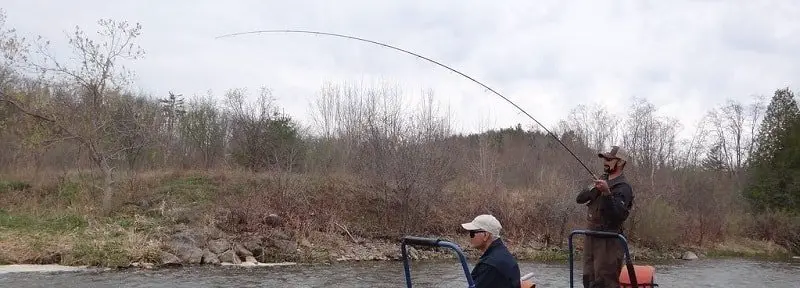
I started centerpin fishing over thirty years ago, long before most anglers even knew what it was.
I would argue with anyone that fishing with a Centerpin is the most effective way to catch trout, steelhead, and salmon in a river, plus, it’s a lot of fun.
I have taught thousands of anglers how to centerpin. The tactics, tips, and methods I’m about to share can significantly increase the amount of fish you catch. If you don’t fish the same way guides do, you’re probably missing a lot of fish.
But before you read any further, this is the shortened and revised article. The full article covers everything in-depth with twice as much information and many more tips. See the full article HERE.
What You Should Know About Centerpin Fishing?
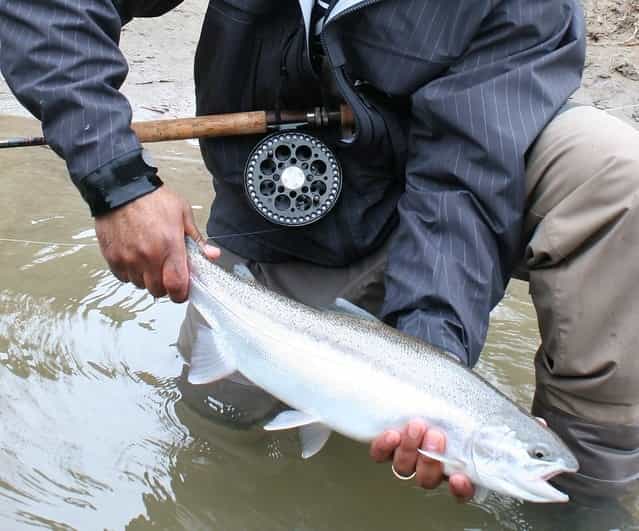
Centerpinning, as the locals call it, uses a unique reel called a Centerpin reel combined with an extra-long rod that is usually between 12 and 14 feet, and a monofilament or braided line.
The long rod and the free-spool function of the reel allow anglers to present bait under a float with extreme precision.
Although it can be the most effective method, I can tell you from 33 years of experience that it’s only effective if you know how to do it well, and if your setup is correct.
I tell anglers that there are four key fundamentals that both new and experienced anglers need to know and get good at. If you mess up even one of them (many anglers do) you will struggle to consistently catch fish.
These are the four key fundamentals to Centerpin fishing that you must know and do well.
- Setup: Your setup, which includes the rod and reel and how it’s set up, and especially your leader rig, must be done correctly. I’ll show you the leader setup that I use to put over 300 steelhead in the net every year.
- Speed Control: Most anglers do not understand this concept well, but it is one of the most important parts of presenting your bait in a way that makes fish want to eat it.
- Covering The Water: I fish methodically and emphasize covering all potential spots within a spot so my clients don’t miss fish.
- Strike Zone: Finding the bottom is a skill all on its own. Part of finding the bottom is learning how to use your float properly, which includes setting the proper depth. I have methods for doing this well.
What Is Centerpinning?
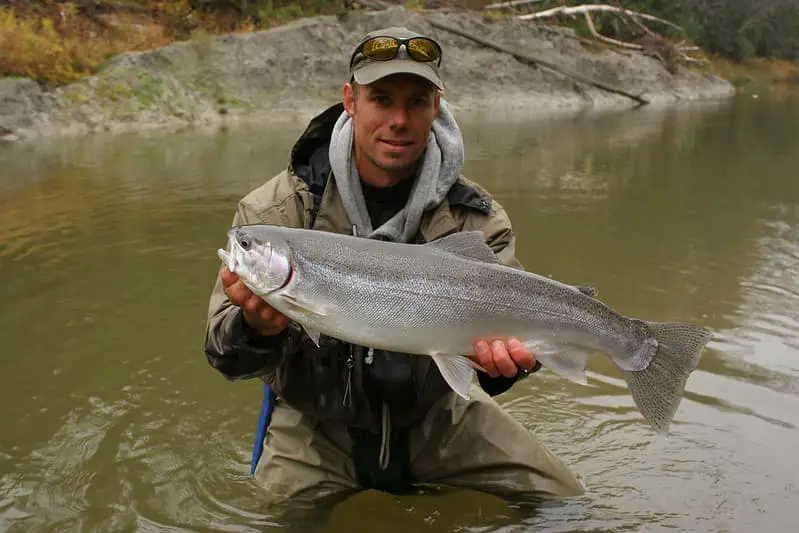
Centerpinning is a popular method that uses a float to suspend and present a bait to fish in rivers, which is why it’s also known as float fishing.
It is used in the Great Lakes region and West Coast for steelhead, salmon, and trout.
Centerpin Origins and History
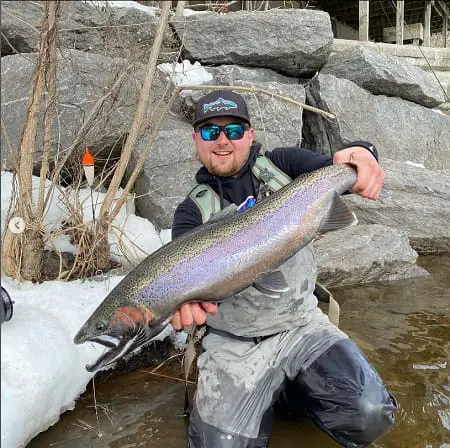
The first Centerpin is rumored to have been used in the UK or Europe where carp anglers used it to fish lakes.
I’m told it was a Canadian angler from Ontario who brought the first Centerpin over to fish for steelhead. That was over 40 years ago.
It is now one of the most popular methods of steelhead and salmon fishing around the Great Lakes region and on the West Coast.
Why Centerpin Fish?
The simple truth is that Centerpin reel allows you to get a much better presentation when float fishing than spinning reel or baitcasting reels which usually results in more fish.
The reason is the smooth high-end bearings that allow the float to easily pull line of the reel.
You can get a more controlled and smoother presentation, make much longer drifts, and have fewer line problems.
I can honestly say that when it comes to drifting bait under a float in a river, you can not beat the Centerpin reel.
The Centerpin Reel: The Reel With No Drag
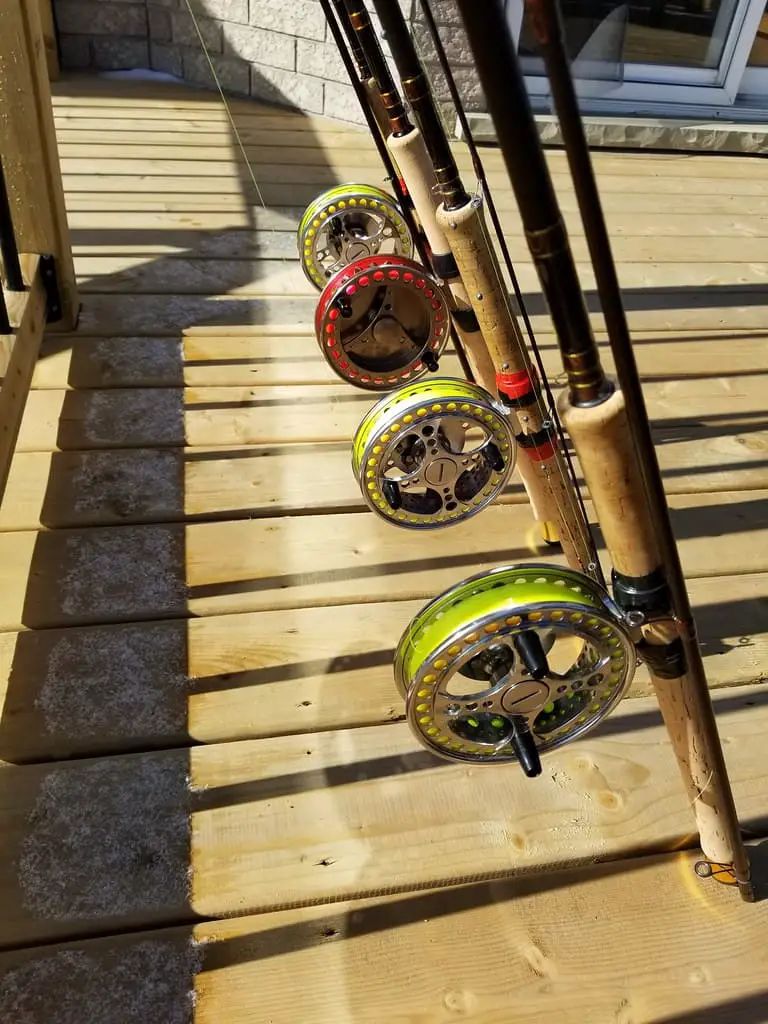
The Centerpin reel is a large rounded spool reel that is usually between 4″ and 5.5 inches in diameter, and the spool sits on a single pin (or post) in the middle of the base of the reel.
The spool uses very high-quality bearings that allow it to spin freely around the pin both backward and forwards, and there is normally no drag on a Centerpin reel.
I discuss some of the best reels on my page “Best Centerpin Reels“.
How To Use A Centerpin Reel
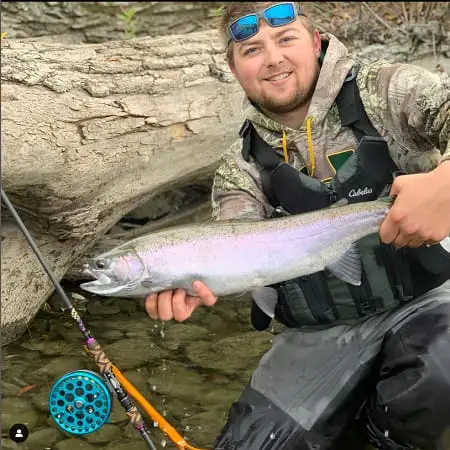
One the float and bait are cast out, anglers can then use their fingers on the rim of the reels spool to control the speed of the float, which then controls the speed of the bait, which is critical to catching more fish.
Anglers also use their hands to stop the reel, to set the hook, and as a drag when fighting the fish.
How To Set Up A Centerpin Reel Properly?
Setting up your reel properly and with the correct hand will ensure better success with a Centerpin reel.
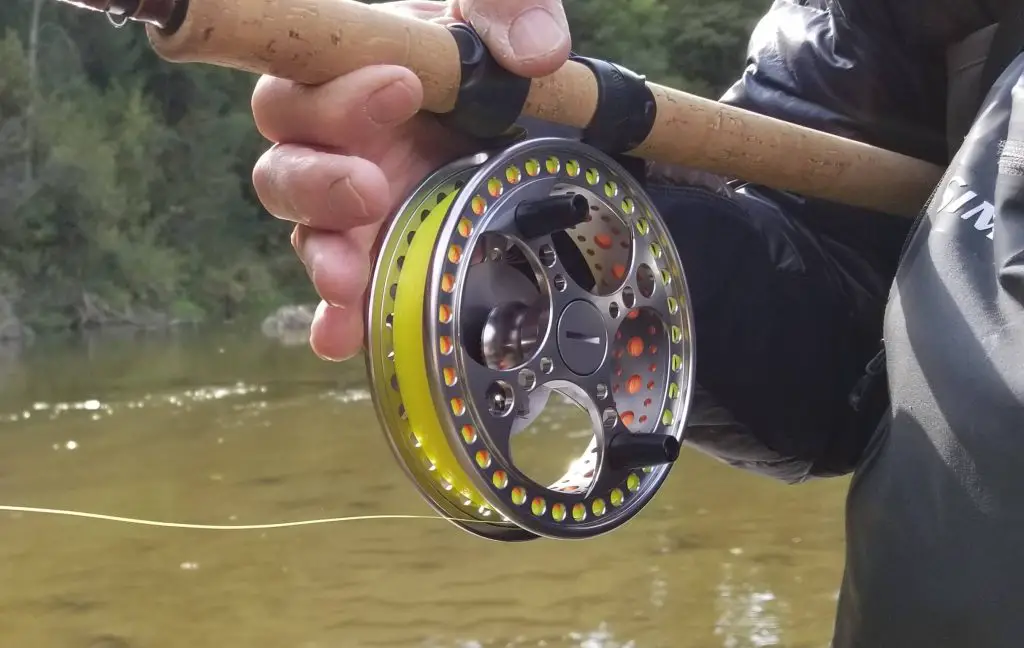
Left Hand or Right Hand – If you are going to Centerpin fish then you might as well start the right way.
Centerpin reels are made to go both forward and backward, so you can use them for right-handed retrieve or left-handed retrieve without any adjustments or handle changes just by switching which side of the rod the handle go on.
In a nutshell, if you are right-handed, you need to use your left hand to reel, and you MUST put the line on the right way for this hand. If you are left-handed you need to use a right-handed reel. There are many reasons why.
Centerpin Line
The line used for Centerpin reels is either a monofilament or braided line. It is crucial to use a recommended line.
Some lines are more buoyant and lightweight than others, and these are the lines you want to use. These lines will make casting, line control, mending, and setting the hook much easier.
I use and recommend using the lightest line possible.
A lighter line casts better, sags less, mends easier, and sinks less. I’ve also found that lighter lines don’t tangle as often. I prefer the Raven Mainline, and I also prefer brightly colored lines, which you can see on my page Best Lines For Float Fishing.
How To Put A Centerpin Reel On
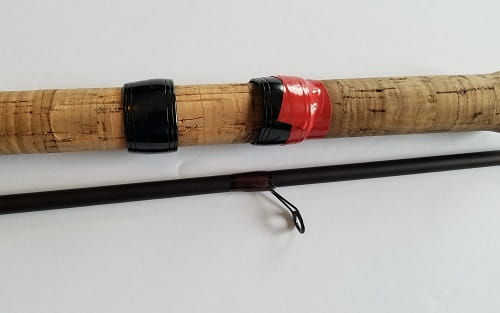
There are two types of rod handles, A fixed reel seat and a sliding rings real seat. Both have advantages and disadvantages.
I prefer a sliding-rings reel seat, which enables me to put the reel anywhere on the handle, which can balance out the rod and reel, and can also aid in fishing and fighting fish.
Not putting the reel on a sliding-rings handle properly can lead to your reel falling off, or affecting your ability to hook and fight fish, as well as wrist and arm fatigue.
I discuss proper hand retrieve, and proper grip, as well as how to set up your Centerpin reel, and what lines to use on my page how to set up a Centerpin reel.
How To Hold A Centerpin Reel
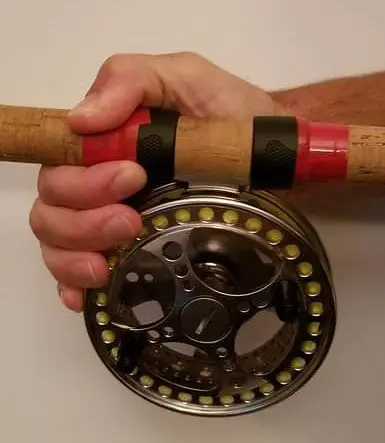
You will be holding the reel all day, casting, fighting some big fish, and controlling the line as it comes out, so your grip on the Centerpin reel must be comfortable and functional.
The grip in the picture is the most common grip and is similar to what I use.
This grip allows the angler to have a good grip on the rod and on the reel while still being able to easily control the rim of the spool.
There are four things to consider when holding a Centerpin reel.
- Comfort
- Casting
- Control of the spool
- Fighting fish.
I cover all of this and show you four ways to hold a Centerpin reel that work well, all on my page How To Hold A Centerpin Reel: 4 Ways That Work Well.
How To Cast A Centerpin Reel
There are five different casts that guys use, but I only teach 2 of them. I have witnessed anglers using the other ones with little success or with some difficulty.
All the top Centerpin anglers and the top Centerpin guides that I know use the Side Cast, or the Wallace Cast. The swing cast is another cast primarily used out west.
I cover these casts and more on my page How To Cast A Centerpin Reel: The 3 Best Casts.
The Centerpin Rod

Most Centerpin rods are between 12 and 14 feet long. The benefit of a long Centerpin rod is that it allows you to keep the line off the water for longer, which improves your presentation.
The longer rod also acts like a giant shock absorber to protect your light leader when setting the hook and while playing the fish.
The type of river you fish will determine the best length of rod for you. The size of the fish will also determine the size or strength of the rod.
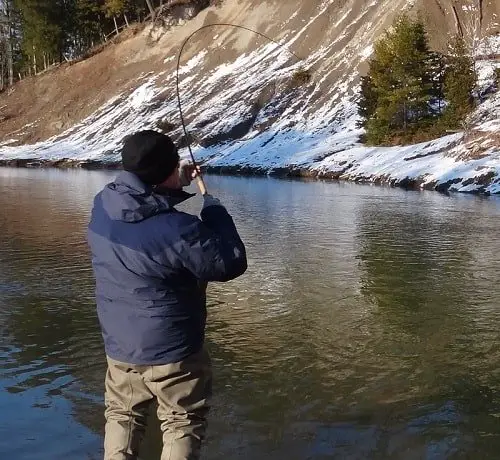
Fishing on rivers that are from 20 to 60 feet wide or wider, a 13-foot Centerpin rod is best.
13-foot rods are what I use the most around the Great Lakes.
Some anglers will use longer Centerpin rods from 14 to 16 feet on very large rivers. Long rods give you more casting distance and line control.
Are Centerpin Combos Good?
I have searched the internet and have not found many pre-made Centerpin combos that I would recommend.
If a combo is in your future, check my page Centerpin Combo – 3 Best Centerpin Rod And Reel Combos
Gear For Centerpinning – Everything You Need
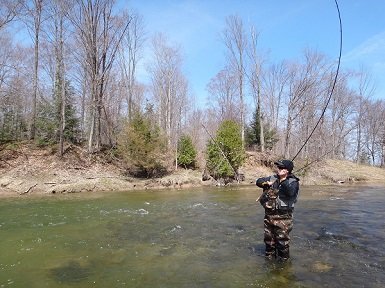
There are a bunch of things you will need for fishing that I consider general river fishing gear.
Stuff like waders, boots, vests, packs, wading jackets, forceps, nippers, nets, and much more.
I discuss all of this on my page River Fishing Gear: Everything You Need To Succeed In 2021.
Centerpin Leader Set Up: A Critical Component
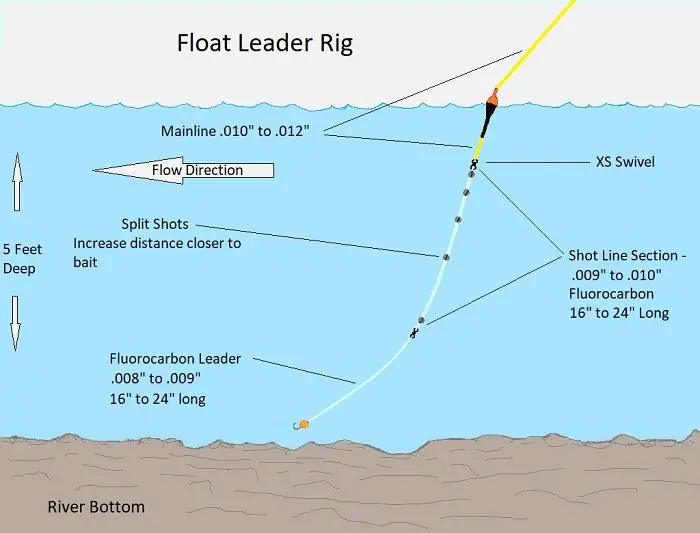
Using the right leader type, the correct size of leader line, and the right leader set-up is critical to catching fish.
Some years, my proven and effective leader setup has put over 500 steelhead in the net for my clients.
Key Elements Of A Centerpin Rig
- The Float, AKA The Bobber: It’s important to use the right type of float. A good float does more than tell you when you have a bite.
- Overall Leader Length: Your leader length needs to be the right length for the spot you are fishing. Too long, and you will drag the bottom and get snagged up often. Too short and you won’t be in the strike zone.
- Shot Line and Weights: The shot line is a section of your leader where you add your weights. Your weights are called split shots, and you must use the correct type and put them on the line in the right pattern. See Best Floats and Best Weights.
- Leader Diameter and Strength: Steelhead are line shy. Using a leader too thick means fewer bites, and using a leader too thin means you will break off a lot of fish. Leader sizes depend on the fish and size of river. Generally, 8 to 12 pounds is for steelhead, and 10 to 16 pounds is for salmon. See Leaders Sizes For Steelhead , Leaders Sizes For Salmon, and Leader Size For Trout.
- Hook: Your hook needs to be the correct size and shape. Use hooks guide use, and adjust the size of the hook to the size of the bait. A good octopus hook like the Gamakatsu or Raven Specien hook is what most guides are using. Size 2 to 10, but that depends on the fish and the bait.
- Swivels: I use Raven XS or XXS swivels.
If you want to know all my proven leader setups, check out my page Steelhead Leaders: Best Float Leader And 2 Proven Setups.
Setting Up Your Centerpin Rig
Before you can set up the rod, you need a few things that you shouldn’t go without.
- Floats: You are going to need a good float that is suitable for the type of water you will be fishing, some floats suck and some are perfect and do the job right.
- Micro Swivel: You will need strong micro swivels for your leader setup.
- Fluorocarbon Leader: You will need at least two different strengths of fluorocarbon leaders. Unfortunately, leader companies DO NOT rate their leader properly and that can seriously affect how many fish bite your line or how many you break off.
- Hooks: You will need a good hook or two. Not just any hook will do, some hooks bend, some are too thick, and some don’t hold as well. I use proven hooks that are proportionate to my bait. Sizes 4 to 10 are common.
There is a lot more that I use on my page Gear To Centerpin Fish– Everything You Need For More Fish.
The Best Baits For A Centerpin
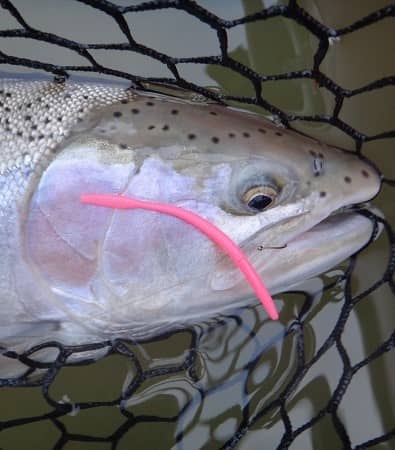
The most common bait is roe or spawn sacks. I do very well with plastic steelhead worms, beads, flies, and even tiny jigs.
On the West Coast, Skein and shrimp are also good baits.
See my Best Steelhead Baits page.
Centerpinning Through The Seasons
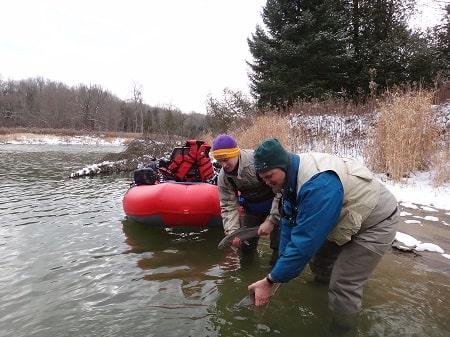
I Centerpin twelve months of the year.
It’s important that you know how to adapt to the changing conditions, what baits work best and when, and where the steelhead, trout, or salmon will hold at different times of the year, or you may struggle to catch fish.
See Also:
- Fishing For Spring Steelhead
- Summer Steelhead Fishing
- Fall Fishing For Steelhead
- Winter Fishing For Steelhead.
Getting A Perfect Presentation

Presentation is the #1 thing you need to master.
Presentation is so important that many times I have guided two clients and watched one of them present their bait perfectly and catch 5 to 10 fish while their buddy with a sloppy presentation catches none.
I have watched thousands of anglers fish, and within seconds, I can tell you if they will catch fish or not because of how they present their bait.
#1 Speed Control Is Critical
Speed control is the #1 most critical thing that you can do to catch more fish, period! Speed control of your float and your bait is part of a great presentation and something you MUST learn.
Most anglers just cast their float out into the current, watch it go, and then hope for a bite. These are the guys that catch one fish when good anglers around them catch ten fish.
Working your float every second of the time during a drift significantly improves your chances of catching a fish! I have proven this over, and over, and over again.
To slow your speed, you need to do something called trotting, which you can easily do by controlling the speed of the line that is coming off the reel. You simply hold the line back just enough that your float tilts slightly upriver.
To learn more about this very critical part of float fishing, check out my page Controlling Your Speed For More Fish When Float Fishing.
#2 Strike Zone: Finding The Bottom
Finding the bottom is the number #2 fundamental to Centerpin fish like a pro.
Finding the bottom is so important that when I teach anglers to Centerpin fish, I often tell them that whenever they fish a new spot, the primary goal is to find the bottom.
You need to find the bottom every time because that is where most fish are holding and feeding!
If they are down 9 feet and your bait is 3 feet over their heads, they probably won’t eat it.
I detect the bottom by using a really good sensitive float and use two simple methods for finding the bottom with that float, which I detail on my page How To Know How Deep To Set Your Float – 2 Easy Ways
#3 Covering The Water Effectively
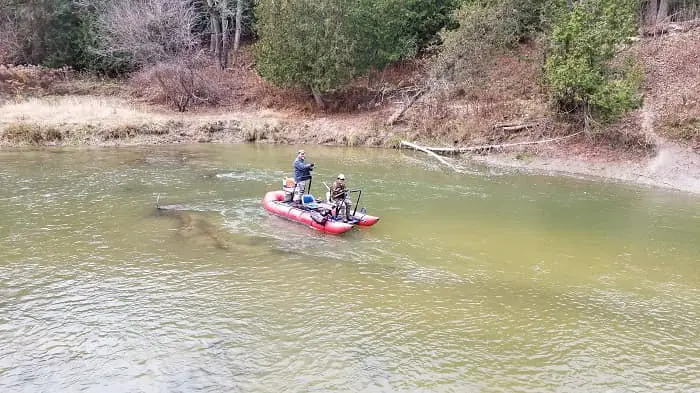
Covering the water effectively is the #3 fundamental for great float fishing.
I fish in lines up and down the river from the closest part of the run to the furthest part of the run.
To cover the water effectively, you need to stand near the top of the spot about one and a half rods length from where the deep water starts. Then cast your float at the edge of the deep water and fish as far down as you can. Then cast about one foot further across and repeat this until you have completely covered all the deeper water without missing any of it.
To see this in more detail, visit my page Effectively Covering The Water When Float Fishing.
Fish From The Top Down
When float fishing with a Centerpin, you are drifting your float down the river. To control your speed effectively and to get a better presentation, you MUST be upriver of your float.
When you start fishing a new spot, get as far up the pool as you can and cast straight out, not upriver and not straight downriver, just straight out toward the far bank and work your float down the river from there.
Being at the top of the spot is the start of covering the water like a pro.
How To Set The Hook With A Centerpin
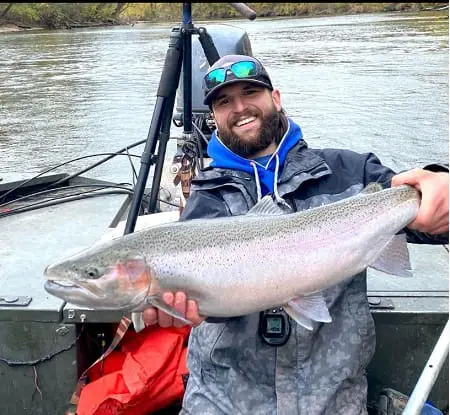
I’ve been hit by flying floats and leaders because guys set too hard, and I’ve seen anglers lose fish after fish because they set the hook too soft or too slow.
And I’ve seen way too many guys tangle the crap out of their leader because they do not know how to set the hook properly.
Many anglers set the hook to slow which results in missed fish, so it is imperative to set the hook the second your float drops.
Set the hook hard enough that the float “pops” on the water. If you set the hook so hard that your float and leader come flying back at you, you’re setting too hard and you’re following through with your elbow.
I discuss setting the hook better on my page How To Set The Hook When Float Fishing.
How To Fight A Fish With A Centerpin
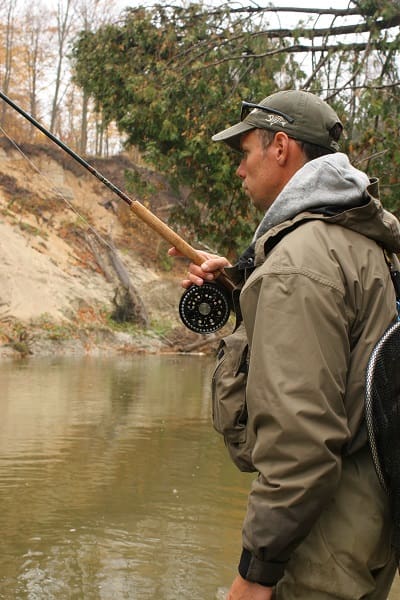
I tell all my clients that I believe 90% of anglers will lose their first good fish on a Centerpin Reel.
There is no drag on most Centerpin reels, so it’s you and the fish playing tug of war, it’s a give and take battle.
New Centerpin anglers either give the fish too much line with not enough pressure on the reel and eventually they lose them after a long fight, or they clamp down too much and then break the fish off.
I apply steady, even, and maximum pressure on the fish using my fingers on the reel spool, and I know how much pressure I can apply before my leader breaks.
I also know when to let them run. If they bolt, I lower my rod and apply steady pressure, and as soon as they stop running, I reel them in
I always maintain a tight line and gentle bend in the rod, and I rarely ever break a fsh off, and I get them in quickly.
How To Land A Fish With A Centerpin
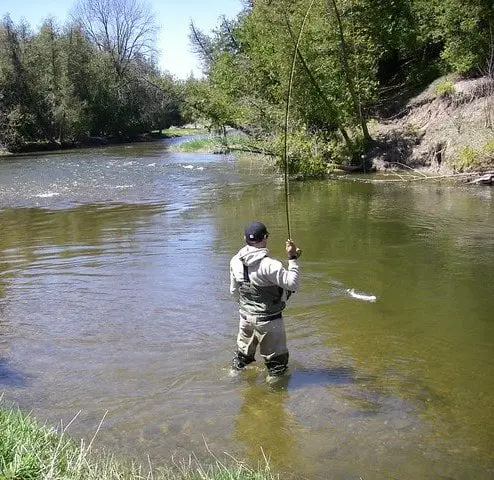
One of the things I see new anglers do wrong when they are about to land a fish is that they reel the fish almost to the tip of the rod. Don’t do this.
That tip is 13 feet away on the long centerpin rod.
Always leave just over a rod’s length of the line from the tip to the fish, and that fish should come right to the net.
And always use a net. For the best steelhead nets for the river, check out my page Steelhead Net: 5 Best Steelhead Nets For River Fishing.
How To Take Care Of Your Centerpin
Most of my Centerpin reels run perfectly for over ten years with no maintenance.
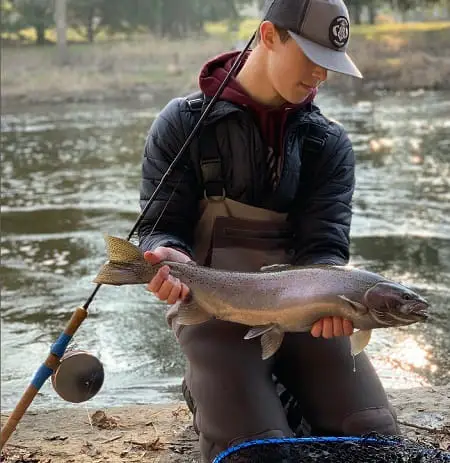
My best advice for taking good care of your Centerpin reel is simple.
Don’t drop it, don’t lie it down on the rocks or in the mud or on the sand, and never put it in the river.
Lean your rod and reel instead of lying it flat on the ground.
Guide Tip: It is very important not to bang your reel or drop it. Doing so may damage the outer fighting rim, which you will feel the dents constantly when fighting a fish and it may even hurt your fingers.
Damaging that rim usually means replacing the rim or the whole reel.
Beginners Education
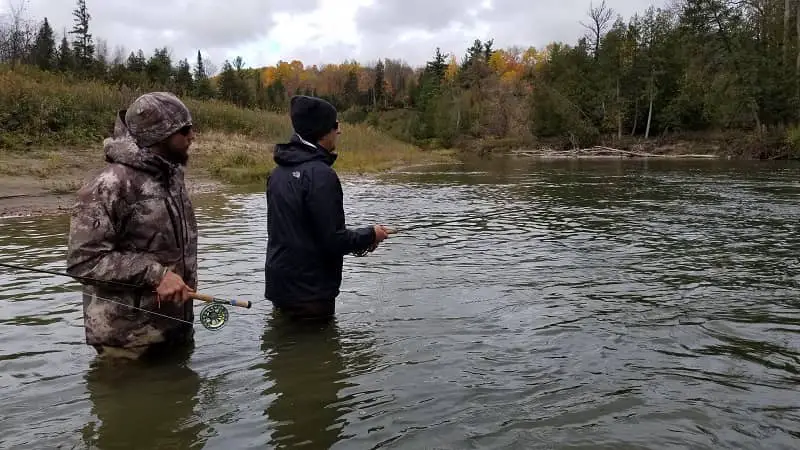
I highly recommend seeking out the Best Centerpin Guides in your area to help you improve your success with a Centerpin Rod and reel.
If the guide is good you should be able to learn more in one day than you could in years of trying yourself.
Centerpin Fundamentals
Here they are in order of importance:
#1. Presentation / Speed Control: Your presentation is the most important thing if you want to catch more steelhead, but, you need to recognize that speed control of your bait is the most important part of that presentation.
#2. Finding The Bottom: It won’t matter if you have a great presentation, and the best bait, and the best setup if you are presenting your bait out of the strike zone. For many fish like pacific salmon and steelhead, and for big trout, their strike zone is often 12 to 24 inches off the bottom, and this is where your bait needs to be. Learning how to find the bottom can be critical.
#3. Covering The Water: Covering the water is essential to catching more steelhead, salmon, and trout with a Centerpin. Covering the water to me means putting the bait in every area of a spot where a fish might be holding and not missing a spot. I use a systematic approach that helps me land more fish.
#4. Setup: Your setup is number four of my top four fundamentals, and this is an easy one if you use a proven setup like the ones I show you on this website. You need to adjust that setup based on the conditions of the river, fish, or spot that you want to fish.
#5 Bait Selection: The bait you use is very important, especially if you’re doing the other fundamentals well, but bait selection, meaning how you choose your bait based on the conditions and what the fish wants is very important.
Don’t get stuck using the same bait all the time, and learn to rotate baits to see if there is something the fish wants more.
BONUS: #6 Fundamental: DO IT ALL TOGETHER: This is equally important to understand. If you have a great presentation and great speed control, but your setup is wrong, YOU WILL STRUGGLE!!
If your setup is perfect and you have the best bait on, which is always the case with my clients, but your speed control or presentation is off, YOU WILL STRUGGLE!!
If you have a great bait, a great setup, and a great presentation, but you cover the water poorly, you will miss fish, and YOU WILL STRUGGLE!!
You must be at least somewhat good at each of the fundamentals and then do them all well simultaneously if you ever want to catch fish like the top 10% of anglers do.. It’s as simple as that!
Tight Lines,
Graham

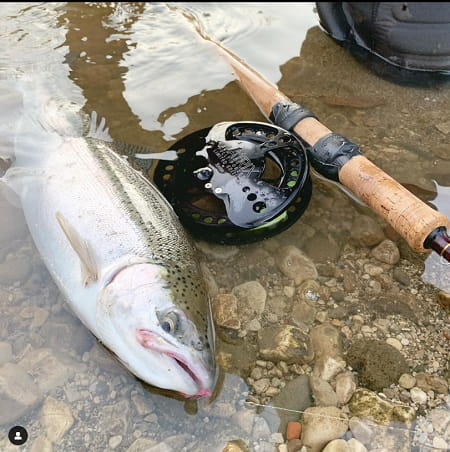
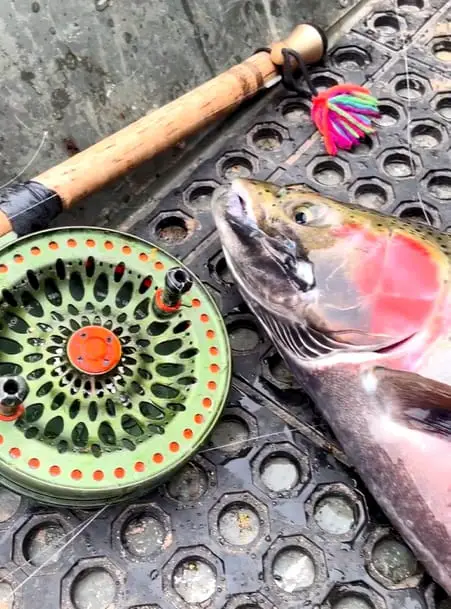
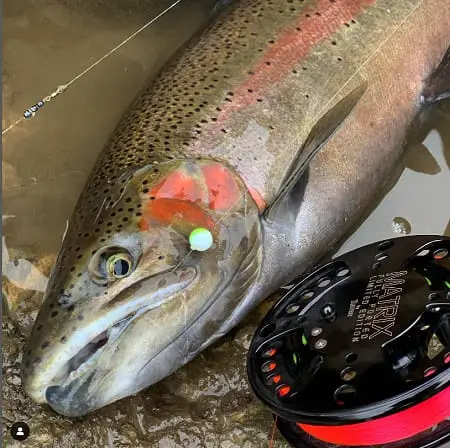
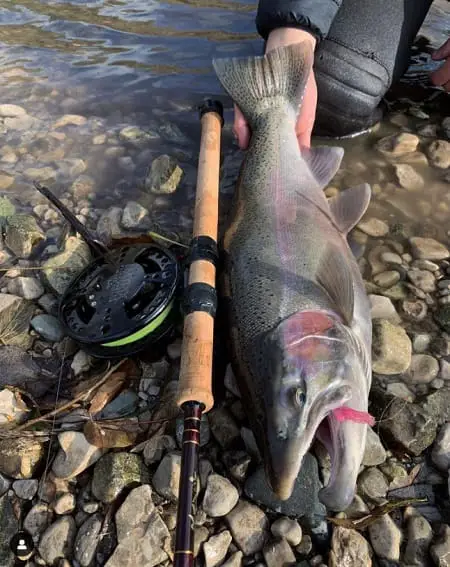
I’m successful with spinners and spoons for steelhead but want to learn and add float fishing to my offerings. Tons of info on line but found your site more specific to help me get started in my preferred small and mid sized rivers off Lake Huron – so thank you Graham. A question for you… in your experience do you recommend reducing the shot size as you work towards the leader?
Hi Larry, I do not decrease my shot sizes from large to smaller near the bait because I find it impractical, unnecessary, and it’s more work to set it up this way with no significant benefit. I also find it more expensive since doing so means I always have to buy and have 4 to 7 different sizes of split shots with me at all times. If I opened up my terminal tackle box you would see only 1 or maybe 2 sizes of split shots because I use the same size shots throughout the leader line set-up, I just increase the spacing nearer to the bait which works the same as decreasing shot size when going from big to small shots. Whether you use the big shot down to small shot pattern method, or the same size shot method with larger spacing like I do it will work the same. The only time I might use a slightly smaller split shot is if I want an extra weight within 12 inches of my bottom bait and I will only add the smaller shot so the fish won’t see it or so that shot doesn’t drag the bottom too much and get hung up. Many of my clients have witnessed me placing an, AA, AB, or BB-sized split shot within 4 inches of a fly or bait and I still catch a ton of fish in gin-clear waters so I don’t believe that a single spit shot that close to the bait will spook the fish. Just make sure you use black or dark gray shots and not shiny split shots. I am working on a page about float fishing that should have all the leader patterns that I use, so keep an eye out for that coming in Jan 2021.
I am interested in center pin fishing for trout and salmon. I have always seen guys pounding the fish this way and want to LEARN how to do it. I have read a bunch of your advice and thinking it’s time to book a trip for a day or two what ever you recommend to learn how to float fish this way. You seem like the most knowledgeable I have meet so far. Please let me know what I need to book a lesson/trip. Thanks John
Hi John, If you are in my area it’s best to checkout my guide service at http://www.aperfectdrfit.com , If you are not in my area its best to search for the best guides near you. I’m working with other great Centerpin guides now and I’m hoping to have a listing of all the top guides for each area soon.
This article is awesome! I have been pinning for about 2 seasons now, and never realized that most of the time, I’m probably not presenting correctly.
What kind of leader set up would you suggest for real shallow runs (about 2ft or less)?
Hey Mike, to be honest, I don’t float fish in 2 feet of water or or less. When float fishing in 2 feet or less water the fish are likely going to see your float and weights and get spooked, unless it’s dirty water. For water that is 2 feet or less, I will switch to bottom bouncing, which can be done with a Centerpin reel or a spinning reel.
If you want to see my best leader set-ups for shallow, mid-depth, and deep water fishing, see my page 5 Best Float fishing Leader Setups
Hope that helps
Hey Graham, that definitely helps! Thanks for all information.
Hey Graham,
Love your website, full of great info and has helped me tremendously.
I went out with a guide a week ago (early Jan 2022) to learn how to properly fish for steelhead with a center pin. I had always fished spinning or baitcaster setups (for 20+ years), center pinning was new to me. We postponed to the following day we had set in the calendar due to cold temps and ice floating on the creek…highs were in the teens that day, but the next day up near 40F. After learning to properly cast, I immediately had my float drop. It seemed like every time I attempted to set the hook on the float drop I’d end up missing entirely, never felt the fish on. I’d reel my float back in to see the roe bag was torn, clearly from a fish biting it. I had watched hundreds of videos of floats dropping and hook sets…I was on hair trigger alert, and my reaction time is quicker than most. Nothing, never got a fish on, it was always a miss, and my float dropped at least a dozen or so times that day. At first I was definitely putting too much energy into the hook set, but later on I refined things a bit and was just “flicking” the rod tip using just my elbow/arm, still couldn’t hook one. Any additional words of wisdom you could provide for honing in on that proper hook set?
Thanks again for all of the invaluable info you provide on your website!
– Chris
Hi, Graham I was wondering if you can use a fly rod with a float fishing reel to float fish?
You could use a fly rod for centerpin fishing, but not a fly reel. A centerpin on a fly rod is not ideal when fishing for bigger fish like steelhead or salmon due to the low position of the reel on the fly rod handle.
Graham
I have read your article 4-5 times and can only pick up the first 3 fundamentals, would you explain #4, #5 I must have read and re read but can’t pick them out.
Hey John,
My bad, I did not state these fundamentals clearly so, I have updated the post, highlighted and added some things or made them more clear, and I have added a summary of each fundamental at the bottom, which also includes 2 bonus things you should know. I hope that helps.
Best of luck,
Graham
Is it possible to book a fishing guide with gram specifically?
Hey Michael,
Unfortunately I’m not available for guiding at this time. What area are you located, maybe I can direct you to a good Centerpin guide?
Graham
hi I have a question for Graham I fish the notty wasaga beach If you catch a female rainbow and she is dropping lose eggs and you milk her eggs. will she live if you release her . Thanks Kevin Morris
Hey Kevin,
Probably not, mortality is high, however, it depends. It depends on how long your keep her out of the water. In my opinion, they survive out of water about as long as you can survive under water. Plus, they are already fatigued from the fight, so they may die out of the water in less time. Overall, it’s not a good practice, especially in a river like that which has high potential for natural reproduction.
I’m surprised you’re getting loose fish that low in the river or lake.
Tight Lines,
Graham
Yes there have been several fish being caught this way above and below sand banks in the last week
Do you have any tips or methods for switching out your leader easily when covering different depths in a pool?
Hi Jay,
I don’t switch out my leader for changing depths unless it’s a severe change over 13 feet. For most depth changes between 3 and 13 feet, I just slide my float up and down the line.
I do have pre-tied leaders wrapped on a Lindy Tackle Tamer incase I need to switch a leader quickly for a client.
Graham